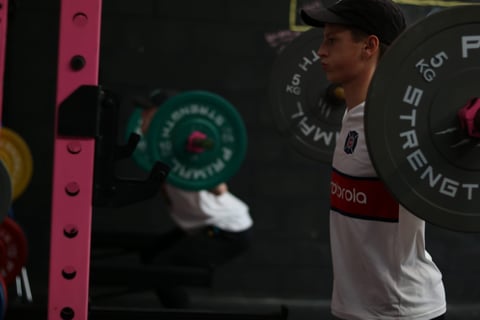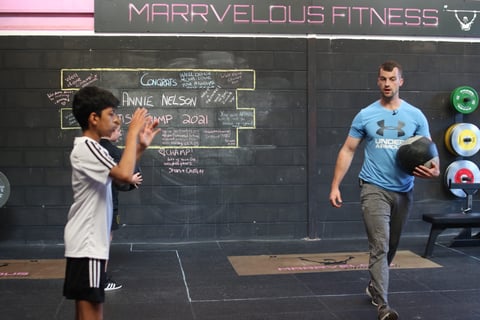Leveraging Growth and Maturation Data to Maximise Strength Training
Resistance training is broadly accepted as a beneficial form of exercise among youth athletes and their stakeholders. What is meant by this is most professional soccer academies, high schools, and private training facilities are promoting strength training for children. Now, as far as improving overall health and wellbeing in children, this is a wonderful advancement. However, from a competitive standpoint, where the goal is to develop better athletes than the high school down the road or the soccer academy the next state over means that coaches need to think bigger than bench press and back squats. To develop better athletes will require use of valuable data points to provide insight to augment performance through real time modification. The purpose of this article is not to overshadow the advancements in the field or our impact on youth athletes, it is to provide some guidance relating to how some of the challenges of working with youth athletes can offer an opportunity to sensibly advance performance sooner by using strength training.
Peak height velocity (PHV) is the period where children experience the second greatest rate of growth in stature. It is through this accelerated period of growth that children can experience a decrement in motor skills, expression of physical qualities, and experience growth-related injuries. In most professional soccer academies PHV is monitored closely to identify what changes in training prescription will be required. Estimated PHV is produced by using a few reliable methods such as the Kamis Roche or the Mirwald method to attain predicted adult height (PAH). Then the current standing height of the athlete is compared to the PAH in the form of a percentile which outputs a growth status. PHV is partitioned into three stages, pre-PHV (<88% PAH), circa PHV (88-95% PAH), and post PHV (>95% PAH).
When an athlete is pre-PHV velocity <88% PAH), it commonly viewed by the inexperienced coach that attempts to promote physical adaptations are futile. While the development of physical change is limited at this stage there are a whole host of opportunities to advance physical change through detailed training prescription. Early to late childhood offers an opportunity to develop and diversify skills as increased plasticity of the brain accelerates the learning process (Hensch, 2004). This stage should be dedicated to learning and upgrading motor patterns such as squatting, hinging, pushing, pulling, and bracing. This is not to say that these skills cannot be learned at a later stage of the growth, however, if this time frame could be leveraged to learn the key movement competencies this will reserve time post puberty to focus on maximising physical development. Now, what changes can be expected in relation to resistance training at this stage of maturation? Research observing the effects of strength training in youth athletes have seen significant neural changes in force production and rate of force development when compared to their untrained counterparts (Myers et al., 2017). The neurological changes were accredited to increased activity of high threshold motor units. While structural adaptation pre-PHV are limited, there were noticeable change in trained youths who had been consistent with resistance training for more than 20 weeks. Structural changes include augmentation of muscle volume, muscle length, and tendon thickness. It is through these physical adaptation during childhood that we can set the athlete up to maximise training prescription appropriate for a more mature physical structure.
During PHV (88-95% PAH), maturing children have been shown to grow between 5-12cm per year. This can be categorized by high growth tempo (>7.2cm/year), moderate (3.5-7.2cm/year), and slow (<3.5cm/year). It is during this accelerated period of growth that challenges relating to performance occur (Cummings et al., 2024)). For instance, increased rates of growth in the lower limbs can temporarily implicate movement mechanics, joint range of motion, and proprioception. Each athlete will be influenced to a different degree, however, those who are significantly more effected can be traced back to a greater tempo of growth. In addition, to reduced coordination, growth related injuries may also occur if workload is not properly managed. It can be during this time that the strength and conditioning practitioner reduces training load if required. There are a few preferred ways to execute this in weight room. Practitioners will usually reduce sets, reps, range of motion, or load, it is important to bear in mind that when you work with youth athletes you must prioritize the execution of the skill. To remove opportunities to practice movements or perform them improperly will hinder the acquisition of the skill. During this point in time, it is most sensible to reduce the load being lifted by the individual. Once the athlete has relearned or restored movement competency it is essential to work towards greater heights of athletic development.
Once the athlete is beyond the growth spurt (>95% PAH), usually peak weight velocity occurs 6-9 months following the completion PHV. This involves the broadening of the shoulders and increases in lean mass in males. It is during this time that increases in strength, power, speed, and endurance occur naturally, however, increased sensitivity to training will occur because of neurological, hormonal, and metabolic augmentations. This means that training should be used to capitalise on the natural changes that have occurred due to puberty. Now, ideally at this point the athlete will have enough exposure to resistance training that the practitioner will be able to prescribe resistance training more aggressively. It is during this stage the athletes will have the most to gain from their strength training. The increases in force production will likely be measured through a series tests relating to speed and power as it will have a high rate of transfer in this stage. Finally, it will set the stage maximise physical adaptations with an improved training status.
The academy system is an asset to every professional soccer club. To maximise the return on investment and enhance player development growth and maturation data must be leveraged to offer insight to appropriate training prescription. This is not to say that it is about developing senior players as quickly as possible, but it is about developing them as quickly as reasonable.
References
Hensch, T. K. (2004). Critical period regulation. Annual Review of Neuroscience, 27(1), 549–579. https://doi.org/10.1146/annurev.neuro.27.070203.144327
Laube, C., van den Bos, W., & Fandakova, Y. (2020). The relationship between pubertal hormones and brain plasticity: Implications for cognitive training in adolescence. Developmental Cognitive Neuroscience, 42, 100753. https://doi.org/10.1016/j.dcn.2020.100753
Monasterio, X., Cumming, S., Larruskain, J., Johnson, D. M., Gil, S. M., Bidaurrazaga-Letona, I., Lekue, J. A., Diaz-Beitia, G., Santisteban, J. M., & Williams, S. (2024b). The combined effects of growth and maturity status on injury risk in an Elite Football Academy. Biology of Sport, 41(1), 235–244. https://doi.org/10.5114/biolsport.2024.129472




